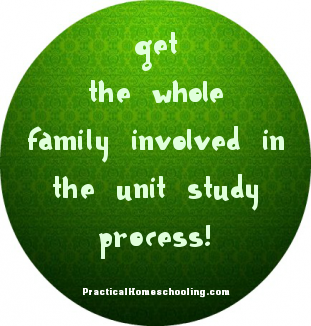 As the homeschooling mother of eight children, I am careful to plan our studies so I have time to explain each subject to each child. This gives me a handle on their level and their ability; it also indicates where they are slack and need a good push. Having so many great curricula from which to choose, I don't want the fact that I have many children to keep me from using these wonderful resources. I have found that if I pray, plan, and plunge in then I can usually find a schedule that helps me fit it all in.
As the homeschooling mother of eight children, I am careful to plan our studies so I have time to explain each subject to each child. This gives me a handle on their level and their ability; it also indicates where they are slack and need a good push. Having so many great curricula from which to choose, I don't want the fact that I have many children to keep me from using these wonderful resources. I have found that if I pray, plan, and plunge in then I can usually find a schedule that helps me fit it all in.
Unit Studies
The basic concept of unit studies is using one source, topic, or literary selection to incorporate the majority of school subjects, especially science, history, social studies and geography, writing, basic grammar, art, and reading. I think of unit studies more as a method that keeps the family unit together in studies.
Most of the stress-free/mom-friendly programs require large daily chunks of time for reading literary selections. I came up with some creative not-so-neat-and-tidy solutions. I also devised ways to use these curricula with both younger and older children, to include the majority of my offspring, my family unit.
Reading Time: Older Read to Younger
I read each chosen selection the first day, to acquaint myself with it, set the mood and tone, explain any unknown vocabulary words, answer basic questions, and enjoy some cuddle time with my troop. Since I have five readers, I put their skills to work the rest of the week by assigning the reading portion to an older child and have him read to the younger ones. This helps with my task and keeps the children busy in a positive direction while building relationships among them; not to mention the wonderful memories being made.
I also give academic credit to the older ones when they carry out "Story Hour" with the little ones, not just reading, but putting some heart into it, and perhaps adding one of the topical activities after enjoying the prose.
Timing is Everything
To alleviate the crunch of reading to several children, while keeping the others on task during school hours, I sometimes relegate the time for reading the books to the afternoon or evening, then do the "schoolwork" portions the next morning, saying, "Remember the book we read yesterday? . . ." So far, this has not interrupted the flow of ideas nor lost the momentum of the atmosphere. But it sure allows me some flexibility while my hands are full juggling my divided attention between baby, toddler, preschool, elementary, junior-high and high-school levels.
Or . . . Daddy to the Rescue
Sometimes I enlist my husband to read to the children in the evening. This gives me some much-needed time off. It also provides constructive time for daddy and the children, so they are moving in a positive direction, not just falling into the same rut of flipping on a video or reading a magazine and tuning out. Additionally, this includes Dad in the schooling, enabling him to ask relevant questions, and make suggestions to me concerning his view of the children's academic strengths and weaknesses - assessing where they need work and where they excel.
Older Ones: Basic Writing
For our older children, who are insulted if we try to leave them out of read-aloud times, I planned a language scope and sequence that envelops and enlarges on the planned topics. Starting with the basics of writing sentences, then writing good sentences, we progress to adding adjectives and descriptive words. Next we vary the verbs, using more precise, concise words, followed by writing good topic sentences for paragraph formation. This helps include everyone, keeping the family unit tone, while each child works on his own academic level. It also makes my planning time easier, not having several different curricula for the various age groups.
Poetry
Loving the wonderful poems of Robert Frost and others, I make a beeline for any portions of curriculum that deal with rhyme. We include reading and writing verse, to satisfy my desire to instill in them a fondness for poetry, while teaching them how to write it themselves. Encouraging my children to "just write a poem" doesn't work, so we use a program for writing poetry to continue for several weeks or more. Sometimes, it helps to use a topical resource from the library. Reading poetry with everyone encourages "familiness" that we so enjoy, but they write on their own level. Beginning with the basics, we practice specific points each week: identifying rhyming words (those with the same vowel and ending sounds); saying words that rhyme with a word I give; writing couplets (two sentences or lines that rhyme at the end); composing a simple rhyming poem; haiku, cinquain, multiple verses; and so on.
In this fast-paced world where family time is scarcer than in bygone days, I appreciate anything that helps us move forward in our goals while keeping the family unit intact. These are a few ways I have found to make a pre-written curriculum work for multiple age levels, making it easier on the teacher (mom). It also helps keep the family unit feeling that unit studies provide.